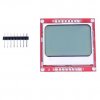camerart
Well-Known Member
Hi,
Has anyone got one of these 5110 screens to work with a PIC?
This thread is now only for the 5110(since 061017), although some of the comments for this screen are still here: **broken link removed**
THREAD link: https://www.electro-tech-online.com/threads/oshonsoft-graphic-and-touchscreen-lcds.152168/
Camerart.
Has anyone got one of these 5110 screens to work with a PIC?
This thread is now only for the 5110(since 061017), although some of the comments for this screen are still here: **broken link removed**
THREAD link: https://www.electro-tech-online.com/threads/oshonsoft-graphic-and-touchscreen-lcds.152168/
Camerart.
Attachments
Last edited:


 , and while I've got it back working with the 24F, I haven't got it on the 16F1827 again yet - it didn't work, I don't why, and I haven't had the time to delve deeper. Originally I developed the code on the 1827, then later moved it to the 24F - this time I couldn't get the 1827 to work, so tried on the 24F and it did?.
, and while I've got it back working with the 24F, I haven't got it on the 16F1827 again yet - it didn't work, I don't why, and I haven't had the time to delve deeper. Originally I developed the code on the 1827, then later moved it to the 24F - this time I couldn't get the 1827 to work, so tried on the 24F and it did?.